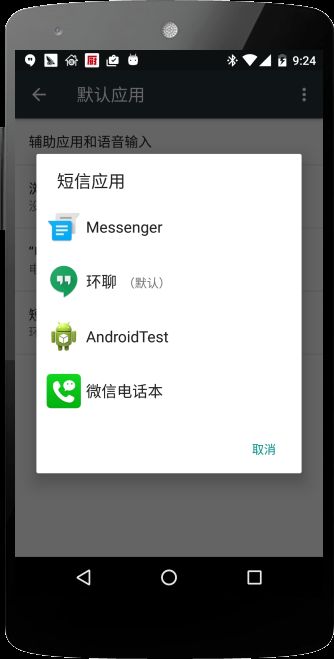Android短信拦截机制适配的坑(下)--4.4以上系统,主要是6.0
前一篇文章,Android短信拦截机制适配的坑(上)--4.4以下系统
介绍了广播接收的顺序,但是我明确说明在4.4以下系统,那么4.4及以上系统会遇到说明问题呢?
首先我们要来了解4.4系统短信的机制的改变,主要是这篇文章
http://android-developers.blogspot.com/2013/10/getting-your-sms-apps-ready-for-kitkat.html
还有两篇篇中文翻译大家也可以看看
http://blog.csdn.net/maybe_windleave/article/details/17740345
让你的短信应用迎接Android 4.4(KitKat)
下面我再来说明一下google对短信机制的修改,首先一个原则是,
4.4及其以后系统,只能设置一个默认的SMS短信app,但短信到达,首先会通知这个app,并且只有这个app有对短信数据库的修改权限和短信的发送权限
并且短信广播,不再是有序广播,也就是App没有办法拦截这个广播,所有app都快接收到短信到达的广播通知,但是只有默认SMS短信app可以修改短信记录
但是!不排除有些操作系统,例如小米会修改这个机制!
那么我再次拿我上一篇文章的需求来说,
需求是:新短信到达以后,项目app希望可以提示用户未读短信的数据,并且可以将短信置为已读。
问题是:和微信电话本冲突的情况,由于微信电话本也要实现上述功能,可是它有一个坑就是,它收到短信以后,就将短信置为已读
解决方法是:比微信电话本更早接收到新短信到达的通知,但是可惜的是,由于我的app不是短信app,所以不能这样做以致使用户收不到新短信
但是我们这里只是来说我们要怎么做,才能比微信电话本早。
在前一篇文章中,已经说过了设置最高优先权的办法,这里面临的一个新问题就是,默认Sms短信app还是会比我们先,所以我最好让用户将我们的App设置为默认sms短信app
根据上面的参考文章,我做了一个简单的demo,这个demo让我们可以在系统选项中,将我们的app设置为默认sms短信app
在我们的原生6.0系统的手机上,是这样的,设置-》应用-》默认应用-》短信应用-》选择AndroidTest
怎么才能做到呢?如果大家看了我提到的文章,就应该知道怎么做,如果嫌麻烦,可以看一下我的设置,首先是AndroidManifest的设置
<?xml version="1.0" encoding="utf-8"?>
<manifest xmlns:android="http://schemas.android.com/apk/res/android"
package="com.example.androidtest"
android:versionCode="1"
android:versionName="1.0" >
<uses-sdk
android:minSdkVersion="8"
android:targetSdkVersion="21" />
<uses-permission android:name="android.permission.WRITE_SMS" />
<uses-permission android:name="android.permission.READ_SMS" />
<uses-permission android:name="android.permission.RECEIVE_SMS" />
<uses-permission android:name="android.permission.RECEIVE_MMS" />
<application
android:allowBackup="true"
android:icon="@drawable/ic_launcher"
android:label="@string/app_name">
<activity
android:name=".MainActivity"
android:label="@string/app_name" >
<intent-filter>
<action android:name="android.intent.action.MAIN" />
<category android:name="android.intent.category.LAUNCHER" />
</intent-filter>
</activity>
<receiver android:name="com.example.androidtest.SmsReceiver" android:permission="android.permission.BROADCAST_SMS">
<intent-filter android:priority="2147483647">
<action android:name="android.provider.Telephony.SMS_DELIVER" />
<action android:name="android.provider.Telephony.SMS_RECEIVED" />
</intent-filter>
</receiver>
<!-- BroadcastReceiver that listens for incoming MMS messages -->
<receiver android:name=".MmsReceiver"
android:permission="android.permission.BROADCAST_WAP_PUSH">
<intent-filter>
<action android:name="android.provider.Telephony.WAP_PUSH_DELIVER" />
<data android:mimeType="application/vnd.wap.mms-message" />
</intent-filter>
</receiver>
<!-- Activity that allows the user to send new SMS/MMS messages -->
<activity android:name=".ComposeSmsActivity" >
<intent-filter>
<action android:name="android.intent.action.SEND" />
<action android:name="android.intent.action.SENDTO" />
<category android:name="android.intent.category.DEFAULT" />
<category android:name="android.intent.category.BROWSABLE" />
<data android:scheme="sms" />
<data android:scheme="smsto" />
<data android:scheme="mms" />
<data android:scheme="mmsto" />
</intent-filter>
</activity>
<!-- Service that delivers messages from the phone "quick response" -->
<service android:name=".HeadlessSmsSendService"
android:permission="android.permission.SEND_RESPOND_VIA_MESSAGE"
android:exported="true" >
<intent-filter>
<action android:name="android.intent.action.RESPOND_VIA_MESSAGE" />
<category android:name="android.intent.category.DEFAULT" />
<data android:scheme="sms" />
<data android:scheme="smsto" />
<data android:scheme="mms" />
<data android:scheme="mmsto" />
</intent-filter>
</service>
</application>
</manifest>
其实
1、是设置短信获取的权限
2、是设置SmsReceiver,MmsReceiver,ComposeSmsActivity,HeadlessSmsSendService,并且这四个一个都不能少,而且对于的action之类的都要设置正确(简单来说,你copy我的,根据自己的实际改改就行了)
接下来为了简单起见,我设置了四个最简单的类
MmsReceiver:
package com.example.androidtest;
import android.content.BroadcastReceiver;
import android.content.Context;
import android.content.Intent;
import android.util.Log;
public class MmsReceiver extends BroadcastReceiver{
@Override
public void onReceive(Context context, Intent intent) {
Log.i("cky","MmsReceiver: "+intent);
}
}
ComposeSmsActivity:
package com.example.androidtest;
import android.app.Activity;
import android.os.Bundle;
import android.util.Log;
public class ComposeSmsActivity extends Activity{
@Override
protected void onCreate(Bundle savedInstanceState) {
// TODO Auto-generated method stub
super.onCreate(savedInstanceState);
Log.i("cky","ComposeSmsActivity");
}
}
HeadlessSmsSendService:
package com.example.androidtest;
import android.app.Service;
import android.content.Intent;
import android.os.IBinder;
import android.util.Log;
public class HeadlessSmsSendService extends Service{
@Override
public IBinder onBind(Intent intent) {
Log.i("cky","HeadlessSmsSendService: "+intent);
return null;
}
}
在SmsReceiver里面,我打印了新短信的信息,并且查询了短信数据库(查询短信权限是有的,但是没有修改权限)
package com.example.androidtest;
import android.content.BroadcastReceiver;
import android.content.Context;
import android.content.Intent;
import android.database.Cursor;
import android.net.Uri;
import android.os.Bundle;
import android.telephony.SmsMessage;
import android.transition.Slide;
import android.util.Log;
import android.widget.Toast;
public class SmsReceiver extends BroadcastReceiver{
public static final String SMS_RECEIVED = "android.provider.Telephony.SMS_RECEIVED";
public SmsReceiver() {
Log.i("cky", "new SmsReceiver");
}
@Override
public void onReceive(Context context, Intent intent) {
// TODO Auto-generated method stub
Log.i("cky", "jie shou dao");
Cursor cursor = null;
try {
if (SMS_RECEIVED.equals(intent.getAction())) {
Log.d("cky", "sms received!");
Bundle bundle = intent.getExtras();
if (bundle != null) {
Object[] pdus = (Object[]) bundle.get("pdus");
final SmsMessage[] messages = new SmsMessage[pdus.length];
for (int i = 0; i < pdus.length; i++) {
messages[i] = SmsMessage.createFromPdu((byte[]) pdus[i]);
}
if (messages.length > 0) {
String msgBody = messages[0].getMessageBody();
String msgAddress = messages[0].getOriginatingAddress();
long msgDate = messages[0].getTimestampMillis();
String smsToast = "New SMS received from : "
+ msgAddress + "\n'"
+ msgBody + "'";
Toast.makeText(context, smsToast, Toast.LENGTH_LONG)
.show();
Log.d("cky", "message from: " + msgAddress + ", message body: " + msgBody
+ ", message date: " + msgDate);
}
}
cursor = context.getContentResolver().query(Uri.parse("content://sms"), new String[] { "_id", "address", "read", "body", "date" }, "read = ? ", new String[] { "0" }, "date desc");
if (null == cursor){
return;
}
Log.i("cky","m cursor count is "+cursor.getCount());
Log.i("cky","m first is "+cursor.moveToFirst());
}
} catch (Exception e) {
e.printStackTrace();
Log.e("cky", "Exception : " + e);
} finally {
if (cursor != null) {
cursor.close();
cursor = null;
}
}
}
}
最后是MainActivity,里面有一个按钮,按一下就将新短信设置为已读
package com.example.androidtest;
import android.annotation.SuppressLint;
import android.app.Activity;
import android.content.ContentValues;
import android.content.Intent;
import android.database.Cursor;
import android.net.Uri;
import android.os.Bundle;
import android.provider.Telephony;
import android.provider.Telephony.Sms;
import android.util.Log;
import android.view.View;
import android.view.View.OnClickListener;
import android.widget.Button;
@SuppressLint("NewApi")
public class MainActivity extends Activity {
SmsReceiver myReceiver;
Button btn;
@Override
protected void onCreate(Bundle savedInstanceState) {
super.onCreate(savedInstanceState);
setContentView(R.layout.activity_main);
btn = (Button) findViewById(R.id.btn);
btn.setOnClickListener(new OnClickListener() {
@Override
public void onClick(View v) {
test();
}
});
}
//将新短信设置为已读
public void test(){
Cursor cursor = null;
try {
cursor = getContentResolver().query(Uri.parse("content://sms/inbox"), new String[] { "_id", "address", "read" }, "read = ? ", new String[] {"0" }, "date desc");
if (cursor != null) {
ContentValues values = new ContentValues();
values.put("read", "1");
for (cursor.moveToFirst(); !cursor.isAfterLast(); cursor.moveToNext()) {
Log.v("cky", "" + cursor.getInt(cursor.getColumnIndex("_id")) + " , " + cursor.getString(cursor.getColumnIndex("address")));
int res = getContentResolver().update(Uri.parse("content://sms/inbox"), values, "_id=?", new String[] { "" + cursor.getInt(cursor.getColumnIndex("_id")) });
Log.i("cky","geng xin = "+res);
}
}
} catch (Exception e) {
e.printStackTrace();
} finally {
if (cursor != null) {
cursor.close();
cursor = null;
}
}
}
}
接下来就是测试
1,当我们没有设置AndroidTest为默认sms短信app的时候,给手机发短信,通过logcat可以看到有新短信,但是数据库查询不到(这个原因见上一篇文章);
点击按钮,没有办法将短信设置为已读(geng xin=0)
2,我将AndriodTest设置为默认Sms短信app,结果如下,我们可以将短信设置为已读了(geng xin-1),并且数据库查询,也有新短信信息
综上所述,就可以使我们的app最先接收到短信了
可是问题是,我们的App既想修改短信数据库,又不想作为短信app,怎么办呢?
答案是凉拌。。虽然google为我们提供了一种机智的方法,就是在我们要操作短信数据库的时候,将我们的app设置为默认sms短信app
数据库操作结束以后,再还原回来
步骤如下:
1查询当前默认的短信应用包名并把包名保存起来。
String defaultSmsApp = Telephony.Sms.getDefaultSmsPackage(context);
2请求用户把你的应用设置成默认短信应用以便进行短信还原(你必须作为默认短信应用才可以写入数据到SMS Provider中)。
Intent intent = new Intent(context, Sms.Intents.ACTION_CHANGE_DEFAULT); intent.putExtra(Sms.Intents.EXTRA_PACKAGE_NAME, context.getPackageName()); startActivity(intent);
3当你还原完所有短信之后,请求用户把步骤一保存的应用设置回默认短信应用。
Intent intent = new Intent(context, Sms.Intents.ACTION_CHANGE_DEFAULT); intent.putExtra(Sms.Intents.EXTRA_PACKAGE_NAME, defaultSmsApp); startActivity(intent);
上面的做法,看起来不错,但是在实际应用中,大部分操作系统都会弹出一个确认窗口,只有用户点击了以后,才能修改成功
就是这个弹出窗口,影响用户体验(意味着每次app修改短信数据库,都会有弹出窗口);
并且这个窗口弹出以后,和你的数据库操作是异步的,也就是可能用户还没有确认关闭这个窗口,你就进行了数据库操作,结果导致操作失败
至于怎么监听这个系统级的弹出窗口,我还没有办法,有知道的朋友可以给我说说谢谢!
文章到此结束,不得不说,Android适配的坑实在是太多了!


